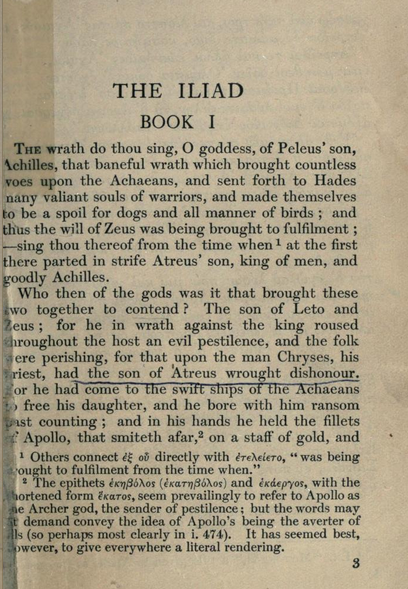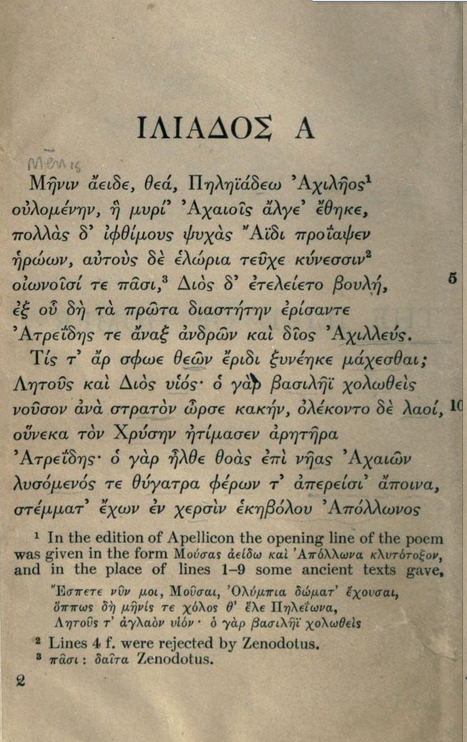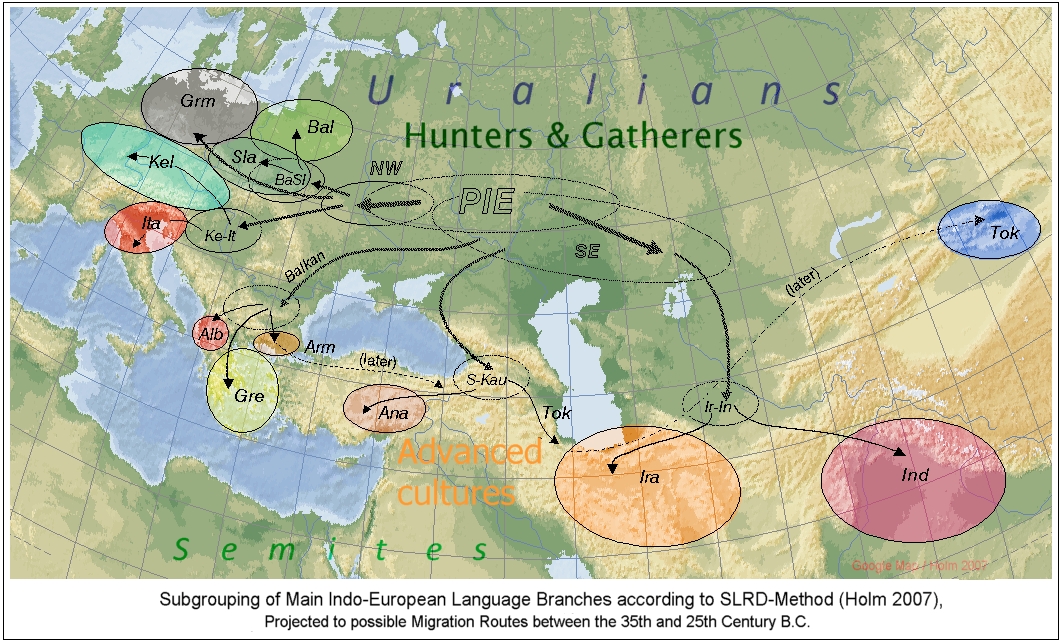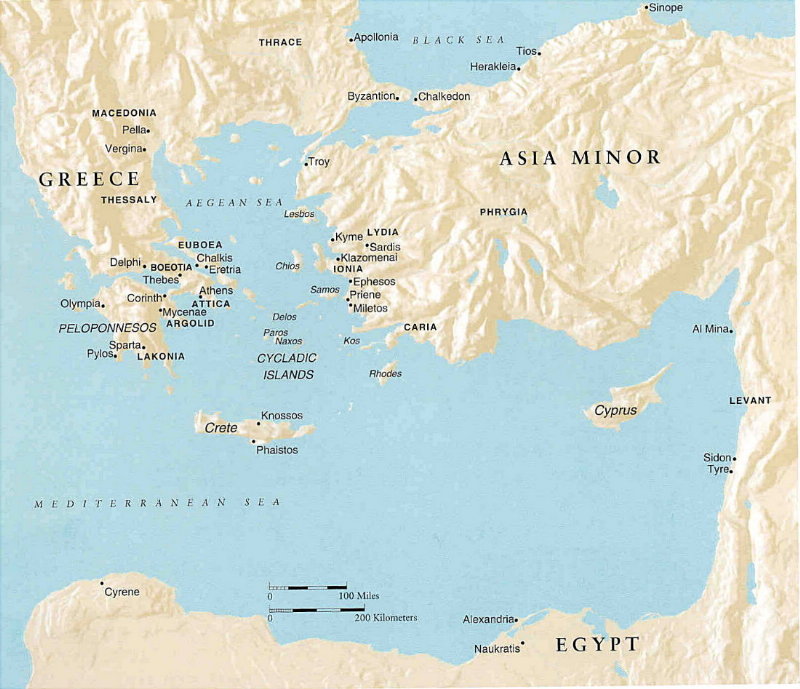 Home Page
Home Page
ILIAD
INTRODUCTION TO
THE ILIAD AND THE ODYSSEY
Date. These epics are the oldest surviving
works of Greek literature. They were composed in the
8th century B.C. (750 B.C. for the Iliad, 720 B.C.
for the Odyssey). They took their present form
when Greeks learned to write using the N. Phonecian
alphabet. Before that, the Greeks communicated it by
oral tradition before that. The Greeks modified N.
Phonecian alphabet. Related to Heb. alphabet.
550-520 B.C.. Peisistratus, dictator of Athens, had
the official text determined.
Author. Homer. We have
little reliable information about him other than that he was
blind and may have been from island of Chios. He
probably made money singing at festivals. Milman Perry
in the 1920s speculated that Homer composed orally. He
would not have memorized the epics word for word,
but would have generated the story at short
notice. It was therefore different every time Homer
sang it. Perry got a Turkish singer to sing about
10,000 lines by lavishly praising him.
Homer used traditional material. A scribe probably
wrote while Homer dictated, letting him plan as he waited
for the scribe to catch up.
Religion & Myth. The Greeks worshipped
two types of gods: Olympian and Chthonic. The
twelve Olympian gods
were Zeus, Hera, Poseidon, Demeter, Apollo, Artemis, Ares,
Aphrodite, Hermes, Athena, Hephaestus, Hestia (Guthrie
111).
Unity. Most now
think one person composed most of Iliad & one person
composed Odyssey. We do not know if it was the same
author who wrote both. If so, there was probably a
30-year gap between Iliad & Odyssey.
Length. Iliad 12,000
lines. Odyssey 15,000 lines. The division into
24 books was done later, perhaps at Alexandria.
Genre. Epic
poem. A long, nationalistic poem in dactylic
hexameter. A hexameter has six metrical feet.
Dactylic hexameter consists of six dactyls or
spondees. A dactyl is a long syllable followed by two
short syllables. A spondee is two long
syllables. An epic helps form the identity of a
people.
Scene. The Iliad
focuses on an event toward the end of the 10 year Trojan
war, but works in references to past & future.
Trojan War. Paris Alexandros sparked the war when he
took Helen, who was the wife of his host, Menelaos.
Menelaos' brother, Agamemnon, led the Greek coalition
against Troy. The Odyssey picks up 10 years later,
when Odysseus is about to return home; it then gives a
flashback to the events of the ten-year trip.
The Trojan Cycle was a series of epic poems
that covered the other events in the Trojan War. The
following is based on the summaries of Proclus.
- Cyprian Lays by Stasinus of Cyprus or Hegesinus of Salamis. It related the first causes of the war. Zeus wanted to relieve overburdened earth, and Eris threw the apple of discord, leading abduction of Helen. Goes through the quarrel of Achilles & Agamemnon.
- Iliad. The quarrel of Achilles & Agamemnon through the death of Hector.
- Aethiopis by Arctinus of Miletus (776 B.C.). The Amazon Penthesilea comes after Hector's death to help Trojans. Ethiopian Memnon falls. Paris's arrow kills Achilles. Odysseus & Aias fight for Achilles weapons.
- Little Iliad by Lesches (660 B.C.). Elaborates the Sack. Odysseus gets Achilles arms. Aias' (Ajax's) madness. Making wooden horse.
- Sack of Troy by Arctinus. The wooden horse, Achaeans return from Tendos, sack Troy, divide spoils, burn city.
- Returns by Agias or Hegias of Troezen. Dispute between Agamemnon & Menelaus, Menelaus' departure from Troy. Death of Agamemnon. Orestes' vengeance on Aegisthus. Menelaus' arrival back home.
- Odyssey by Homer. The return of Odysseus to his home after the Trojan war. 1st travel-adventure story.
- Telegony by Eugammon of Cyrene (568 B.C.) Odysseus adventures in Thesprotis after killing Suitors then returns to Ithaca. Killed by Telegonus, his son by Circe. Telemachus marries Circe; Telegonus marries Penelope; they all appear on the Geraldo show.
BIBLIOGRAPHY
- Fisher, Elizabeth A. "The Study Question: An Avenue to Understanding Homer." Approaches to Teaching Homer's Iliad and Odyssey. Ed. Kostas Myrsiades. Approaches to Teaching World Literature 13. New York: MLA, 1987.
- Guthrie, W. K. C. The Greeks and Their Gods. Corr. ed. Boston: Beacon, 1954.
- Hadas, Moses. Humanism: The Greek Ideal and Its Survival. New York: Harper, 1960.
- Hesiod. Hesiod, the Homeric Hymns, and Homerica. New & rev. ed. Trans. Hugh G. Evelyn-White. The Loeb Classical Library. 1936. Cambridge, Massachusetts. Harvard U. Pr., 1959.
- Nagler, Michael N. "Homeric Epic and the Social Order." Approaches to Teaching Homer's Iliad and Odyssey. Ed. Kostas Myrsiades. Approaches to Teaching World Literature 13. New York: MLA, 1987. 57-62.
- Nagy, Gregory. The Best of the Achaeans: Concepts of the Hero in Archaic Greek Poetry. Baltimore: John Hopkins U. Pr., 1979.
- Papovich, J. Frank. "Focusing on Homeric Values." Approaches to Teaching Homer's Iliad and Odyssey. Ed. Kostas Myrsiades. Approaches to Teaching World Literature 13. New York: MLA, 1987. 47-56.
- Rexine, John. "The Concept of the Hero." Approaches to Teaching Homer's Iliad and Odyssey. Ed. Kostas Myrsiades. Approaches to Teaching World Literature 13. New York: MLA, 1987. 71-76.

Iliad Study Questions1
- Identify the following. What family relationships (e.g., "husband and wife") and political relationships (e.g., "king and subjects" or "allies in war") exist among the characters? Achaia, Hades, Myrmidon, Styx, Troy. Characters: Achilles, Agamemnon, Aias, Alexandros Paris, Andromache, Aphrodite, Phiobos Apollo, Ares, Artemis, Athene, Briseis, Cronos, Demeter, Diomedes, Glaucos, Hector, Helen, Hephaestus, Hera, Hermes, Hestia, Ilios, Menelaos, Nestor, Odysseus, Pallas, Patroclos, Peleus, Persephoneia, Poseidon, Priam, Thersites, Thetis, and Zeus.
- What characters in question 1 are gods? How are the gods different from humans in The Iliad? How do humans and gods relate? Which gods favor the Trojans? The Greeks?
- Look up the word epithet in a good English dictionary. What kinds of epithets are applied to characters in book 1?
- What is Achilles' tragic flaw? How does it affect the plot?
- Why is there one reaction to Achilles' words to Agamemnon and another to Thesites when he says much the same thing? What is the purpose of the response to Thersites?
- Analyze Paris' character based on books 3 & 6.
- In book 9, Agamemnon sends a delegation to Achilles. What does he offer Achilles to return to battle? What answer does Achilles give? What are his stated reasons?
- Why does Diomedes ask the lineage of Glaucos? Why don't they fight?
- Compare and contrast the following: Achilles and Hector, Achilles and Agamemnon, Helen and Andromache, Hector and Paris, Hector and Andromache (regarding the roles of men & women).
- What happened to Achilles' armor? How did he get new armor?
- In what ways does Achilles go too far following the death of Patroclos? How does he regain his humanity?
- How does Achilles achieve peace?
1These questions are taken or adapted from
Fisher 120-124.

Lecture
The Iliad is written in dactylic hexameter. It is as
dominant in Greek and Latin poetry as iambic pentameter is in
English. It is the meter of epic poetry, didactic poetry,
and is one of two meters used in elegy and epigram. The
measure is one long syllable followed by two short
syllables. While English can accommodate this long-short
pattern, the normal English meter is measured by accented vs
unaccented syllables.
One enduring tradition started by the Iliad and the Odyssey is
the division of epics into 24 books. Which raises the
questions, Why books and why 24?
- Why divide the epic into books instead of chapters? The answer has to do with what we now call data storage and data access. A book at the time was kept on a scroll, and the scroll has to be significantly shorter than a codex (a handwritten bound book with pages). There are two reasons for this brevity:
- The scroll is written on the front side only. A codex uses both sides of the paper.
- A long stroll becomes unwieldy. Imagine going from
Book 1 to Book 24 if the epic were on one scroll. It
would take a long time and would risk damaging the
scroll. In the Bible, for example, the book of Kings
was considered one book, but it took up two scrolls.
Thus I Kings and II Kings in many editions. With a
codex, you can move from the beginning to the end of a book
very rapidly.
- Why 24 books rather than 23 or 25? This is where
learning even the least amount of Greek is beneficial.
The English version doesn't give a clue about why 24 books,
because for some reason it uses Roman numerals:

The Greek version gives us an immediate clue.

The books are labelled Alpha to Omega; there are 24 books
because there are 24 letters in the Greek alphabet. Epics
in this tradition have either 24 books or a number that goes
into 24, such as 12 books, 6 books, or 4, depending on how soon
the poet tires out.

Greek Terms

The theme of the Iliad is the wrath of
Achilles. It's also the first word (μῆνις mēnis),
just so you won't have to wonder.
τιμή timē means honor. Honor was
recognition given to those who deserved it, whether gods or
humans. ἀτιμία atimia is dishonor or disgrace.
The Homeric Greeks had no concept of an internal sense of honor;
it was external and either bestowed or withheld by others.
Achilles come to see is as an illusion because it is so
arbitrary and disconnected from actual accomplishments.
οἶκος oikos means house or household. It is the
main form of social organization in Homer's time. The great
kings of the Iliad and Odyssey are mostly
petty tribal chieftains and usually related to the people under
them. It is a broader term than the modern nuclear family and
includes extended family.
The οἶκος has different ways of relating to the outside
world. When things go well, a relationship of ξενία
xenía (hospitality, friendship) is established between
the host and the stranger (ξένος xenos). BTW, Zena
of warrior princess fame is just the feminine form of xenos,
meaning a stranger who is a woman. But when the
relationship between people goes wrong, a feud emerges.
These can split friendships or even families. The Trojan
War, for example resulted from a crime against ξενία when Paris
ran away with his host's wife, Helen. That's how Helen of Sparta
became Helen of Troy.

Historic Background
Indo Europeans from the Steps of Russia.
3000-2000 BC small groups start moving out

Eventually all the Indo Europeans leave the Steps after 2000 BC
- Celtics moved to France
- Germanic to Germany
- Italic to Italian Pen
- Hellenic to Greek Pen.
- Slavic to Balkans
- Hittites to Turkey
- Persians to Iran
- Aryan to India
- Tocharins to China Passed chariots to Chinese, were absorbed into Chinese culture.
- With Homer, we are looking at the Hellenics.
- Will move to Italics (Romans) next
- Then to Germanic people with Beowulf.
All these cultures were similar. All Indo-European.
Spoke dialects of the same language.
Similar social, legal, religious, & legal structure.
Over time, lost contact with one another, diverged into different races with different outlooks.
Indo European become the elites of the nations they conquer.
In China, they conquer militarily but then are absorbed by the
superior culture they took over.
Normans adapted the French system to Feudalism with Knights. Now start speaking Norman French.
Seems to have happened to the Greeks as well
The civilization they encountered were Minoan in Greece & Crete
These were people who traded with Egypt & others. Had
writing.
By 1600 BC Greeks had overrun Minoans
Had taken mainland Greece and island of Crete. Would keep
spreading to other islands.
Greeks organized in tribal fashion under kings.
Little kingdoms all over the area
The king of Mycenae had more stature than the other
kings.
Had Mycenean settlements all over Greece--Athens, Sparta, Pylos, etc.
After 1600, Myceneans a major power throughout the settled world. Learned to sail from the Minoans, overran the island people there.

Homer describes the Myceneans as they existed around 1200 BC.
His description is somewhat different from what Archaelogy reveals.
Homer depicts a warrior society. One based on fighting.
Classes of Society
|
Sometimes the warriors worked as farmers when they weren't fighting.
Social Structure reflects Divine Structure
Classes of Divinity
|
||
| Status |
Greek |
Norse |
| King | Zeus | Oden/Woden |
| Warrior | Ares | Thor |
| Farmer | Demeter Dionysus |
Freja |
At home, had very structured little kingdoms.
Used Linear B writing to keep records.
Greeks sailed around attacking if the inhabitants were weak, traded with the strong. Stole goods and women. Made women produce linen in 'factories'
Hittites ruling Asia Minor found them troublesome. By the time the Hittites had their army to an area, the Greeks were gone.
Hittites had trouble with Egypt--often at war with Egypt
Both Hittites and Egyptians hired them as warriors.
Hittites & Egyptians had strong central governments.
Myceneans had no central government. Hard to deal with them
Were beginning to make settlements in Asia Minor.
Were very interested in controlling the entrance to the Black Sea.
Greeks attacked the entance (Wilusha / Wilios) around 1200 BC. This is the Trojan War. Ilios
Hittites called the invaders Ahhiyawa
(Homer calls them Achaiwoi)
Achaeans
Suggests the war was real.
